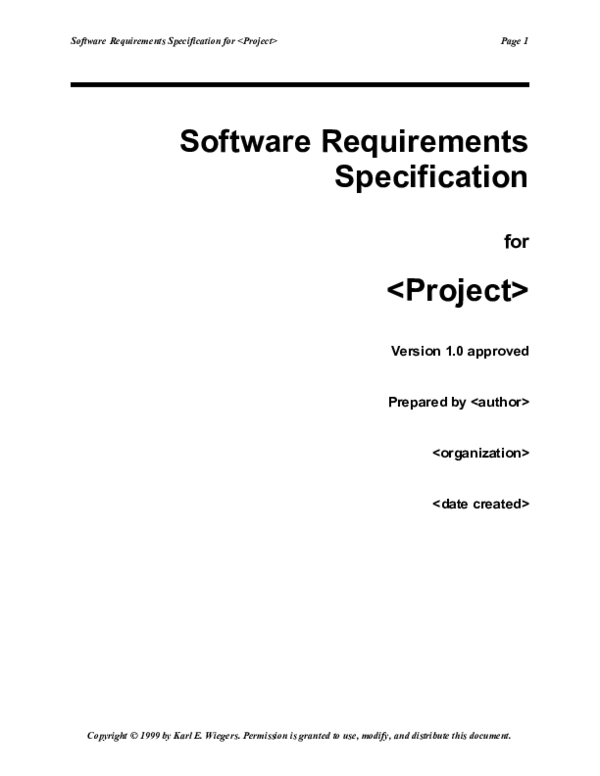Academia.edu no longer supports Internet Explorer.
To browse Academia.edu and the wider internet faster and more securely, please take a few seconds to upgrade your browser.
Software Requirements Specification for <Project> Version 1.0 approved
Software Requirements Specification for <Project> Version 1.0 approved
Related Papers
2011 •
Aunque escasamente conocidos, entre los distintos pueblos originarios del Gran Chaco, se han producido y usado, en múltiples contextos, distintos tipos de objetos realizados con diferentes tejidos y bordados de chaquiras (cuentas de vidrio): collares, brazaletes, pendientes auriculares, anillos, bolsas, cintas, cordones y bandas frontales para la cabeza, etc. Estos se registran, principalmente, en corpus atribuidos a pueblos pilagá, qom (toba) del oeste de Formosa, qom (toba) oriental, maká, nivacché (chulupí) y lengua (enlhet- enxet). En la bibliografía publicada sobre las producciones textiles indígenas del Gran Chaco, ha sido señalada la importancia del empleo de las chaquiras, de los tejidos y objetos elaborados con ellas. Es primordial mencionar que éstas fueron incorporadas por los indígenas chaquenses a través de relaciones con diversas instancias y actores de las sociedades “blancas” (misioneros, militares, ingenios azucareros, etc.), presentes en la región en distintos momentos históricos. Esto reclama nuestra atención sobre las múltiples relaciones entre elementos antiguos y nuevos y, los cambios y las persistencias de estos universos textiles en momentos históricos particulares. En este trabajo, se intentará dar cuenta de lo mencionado más arriba desde el abordaje de la materialidad de los objetos elaborados con chaquiras: materias primas, estructuras textiles de los tejidos y bordados, formatos y, anexamente, motivos, diseños y colores. Cabe aclarar que los resultados presentados en el mismo se produjeron a partir del análisis de colecciones textiles etnográficas bajo la guarda de museos- Museo Etnográfico “J. B. Ambrosetti” (Buenos Aires, Argentina) y Museo Etnográfico “Dr. Andrés Barbero” (Asunción, Paraguay)-, formadas durante la primera mitad del siglo XX. El objetivo principal es dar a conocer un aspecto significativo pero, poco difundido, de los universos textiles indígenas del Gran Chaco, esperando abrir nuevas preguntas sobre sus historias y las de quienes los crearon y usaron.
2011 •
Ria Afrijal
Pembuktian hukum acara persidangan perdataan2019 •
Pembuktian merupakan upaya yang dilakukan oleh pihak yang bersengketa dimuka majelis hakim demi mendapatkan hak dan kebenarannya
文凭老师《爱德华王子岛大学毕业证书原版制作UPEI成绩单》【微信176555708】《仿制UPEI毕业证成绩单爱德华王子岛大学学位证书pdf电子图》,A.为什么留学生需要操作留信认证? 留信认证全称全国留学生信息服务网认证,隶属于北京中科院。①留信认证门槛条件更低,费用更美丽,并且包过,完单周期短,效率高②留信认证虽然不能去国企,但是一般的公司都没有问题,因为国内很多公司连基本的留学生学历认证都不了解。这对于留学生来说,这就比自己光拿一个证书更有说服力,因为留学学历可以在留信网站上进行查询! B.为什么我们提供的毕业证成绩单具有使用价值? 查询留服认证是国内鉴别留学生海外学历的唯一途径,但认证只是个体行为,不是所有留学生都操作,所以没有办理认证的留学生的学历在国内也是查询不到的,他们也仅仅只有一张文凭。所以这时候我们提供的和学校颁发的一模一样的毕业证成绩单,就有了使用价值。 实体公司,专业可靠,办理加拿大毕业证|办美国成绩单|做德国文凭学历认证|办新西兰学位证,办澳洲文凭认证,办留信网认证(网上可查,实体公司,专业可靠)铸就十年品质!信誉!实体公司! 办理国外爱德华王子岛大学毕业证书 #成绩单改成绩 #教育部学历学位认证 #毕业证认证 #留服认证 #使馆认证(留学回国人员证明) #(证)等 真实教育部认证教育部存档中国教育部留学服务中心认证(即教育部留服认证)网站100%可查. 真实使馆认证(即留学人员回国证明)使馆存档可通过大使馆查询确认. 留信网认证国家专业人才认证中心颁发入库证书留信网永久存档可查. 爱德华王子岛大学爱德华王子岛大学毕业证offer毕业证 #成绩单等全套材料从防伪到印刷从水印到钢印烫金跟学校原版100%相同. 国际留学归国服务中心:实体公司注册经营行业标杆精益求精! 国外毕业证学位证成绩单办理流程: 1客户提供办理爱德华王子岛大学爱德华王子岛大学毕业证offer信息:姓名生日专业学位毕业时间等(如信息不确定可以咨询顾问:我们有专业老师帮你查询); 2开始安排制作爱德华王子岛大学毕业证成绩单电子图; 3爱德华王子岛大学毕业证成绩单电子版做好以后发送给您确认; 4爱德华王子岛大学毕业证成绩单电子版您确认信息无误之后安排制作成品; 5爱德华王子岛大学成品做好拍照或者视频给您确认; 6快递给客户(国内顺丰国外DHLUPS等快递邮寄爱德华王子岛大学爱德华王子岛大学毕业证offer)。
Experimental Cell Research
Involvement of CD56/N-CAM Molecule in the Adhesion of Human Solid Tumor Cell Lines to Endothelial Cells1993 •
International Political Economy: Trade Policy eJournal
eUCP and Electronic Commerce Investments: e-Signature and Paperless Foreign Trade2015 •
The developments in electronic documents that are seen in recent years suggest that use of paper will be completely abandoned in all business processes after some time. As an advantage of the developments in information systems, the use of electronic documents has become widespread and even compulsory in some applications. Although it is one of the areas where the benefits of electronic documents will be seen, the use of electronic documents in foreign trade has not become so popular. As the paper-based processes still prevail, it seems that there is a need for a radical and comprehensive change in this area. Although a long time has passed after the publication of eUCP, it has not produced the expected effect, which indicates the necessity of introducing new payment methods to replace letters of credit. In this article, a general evaluation was made within the framework of the latest developments and the possible effects of electronic documents on foreign trade were discussed with ...
Supportive Care in Cancer
Appropriate and necessary oral care for people with cancer: guidance to obtain the right oral and dental care at the right time2014 •
Journal of Pharmaceutical Policy and Practice
The availability of six tracer medicines in private medicine outlets in Uganda2014 •
RELATED PAPERS
Journal of Universal Computer Science
A Tool for Managing Domain Knowledge and Helping Tutors in Intelligent Tutoring Systems2010 •
2021 •
2020 •


 Ahmed Shlsh
Ahmed Shlsh